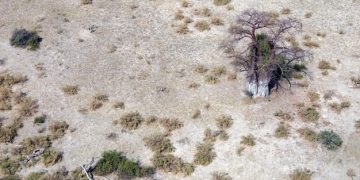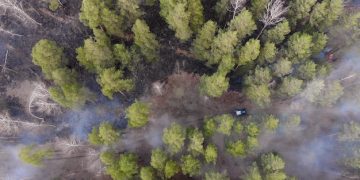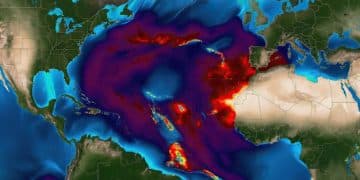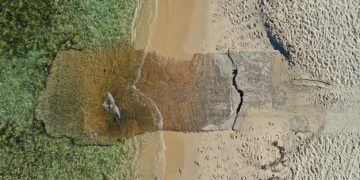Climate Change & Wildfires: US Frequency & Intensity
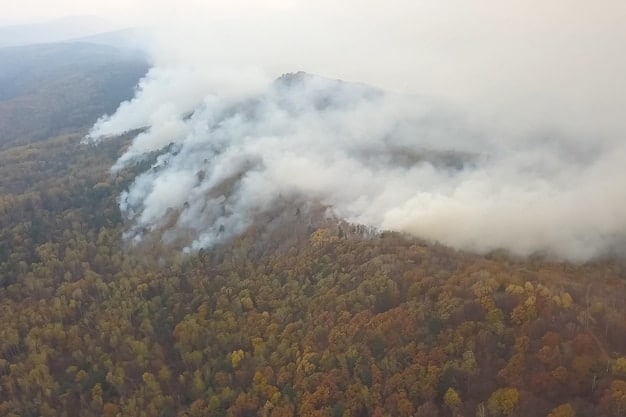
The increasing frequency and intensity of wildfires across the US are significantly influenced by climate change, primarily through rising temperatures, prolonged droughts, and altered vegetation patterns.
Understanding how does climate change affect the frequency and intensity of wildfires in the US is crucial as these catastrophic events reshape landscapes and communities across the nation. The intricate relationship between a warming planet and the escalating fire crisis demands a deeper look beyond sensational headlines.
The Science of Wildfires: A Warming Nexus
Wildfires are complex phenomena driven by a combination of fuel, oxygen, and an ignition source. Historically, wildfires have been a natural part of many ecosystems, playing a role in forest regeneration and maintaining biodiversity. Native American communities, for example, have long utilized prescribed burns to manage landscapes. However, the fires we observe today, particularly in the US, are often far from natural in their scale and behavior. They are becoming larger, more frequent, and more intense, pushing ecosystems beyond their natural adaptive capacities.
The science underpinning wildfires involves understanding the “fire triangle” – fuel, heat, and oxygen. Climate change primarily impacts the fuel and heat components. Rising global temperatures lead to warmer, drier conditions that desiccate vegetation, turning it into highly flammable fuel. This directly translates into an increased likelihood of ignition and more rapid fire spread once ignited.
Understanding Fire Behavior
Fire behavior is influenced by topography, weather, and fuel characteristics. Climate change acts as a force multiplier, exacerbating these factors. Prolonged periods of heat and drought, direct consequences of climate change, create a landscape ripe for burning. When a heatwave strikes an already dry region, the potential for ignition skyrockets, whether from natural causes like lightning or human activity.
- Fuel availability: Drier vegetation means more readily available and combustible fuel.
- Fuel moisture: Lower moisture content in plants allows fires to ignite and spread more easily.
- Wind patterns: Changing atmospheric patterns can lead to stronger, more erratic winds, fanning flames and accelerating fire spread.
Moreover, the concept of “fire seasons” is rapidly evolving. What were once predictable periods of heightened risk are now extending, sometimes spanning the entire year in certain regions. This extension puts immense pressure on firefighting resources and prolongs the exposure of communities to smoke and direct fire threats. The interplay between increased warming and altered precipitation patterns creates a feedback loop that intensifies the wildfire problem.
The changing climate also affects snowpack. Many regions, especially in the Western US, rely on snowmelt for water supply, which also dictates the moisture content in forests later in the season. Reduced snowpack due to warmer winters means earlier snowmelt, leading to drier conditions earlier in the year and extending the period of fire risk. This subtle yet significant change in hydrological cycles is a critical link between climate change and wildfire escalation.
Direct Climate Change Linkages to Fire Frequency
The relationship between climate change and wildfire frequency is not speculative; it is directly supported by observable trends and scientific modeling. One of the most significant linkages is the persistent rise in average global temperatures. Warmer air temperatures increase the rate of evaporation from soils and vegetation, leading to more arid conditions. This desiccation makes forests and grasslands more susceptible to ignition and rapid fire spread.
Another critical factor is the increase in the number and duration of heatwaves. Extreme heat events create ideal conditions for wildfires by drying out fuel sources to critical levels. When combined with strong winds, these conditions can lead to explosive fire growth, making them incredibly difficult to control. Areas previously considered too wet or cool for extensive wildfires are now experiencing unprecedented fire activity.
Droughts and Their Impact
Prolonged and more intense droughts are a hallmark of climate change in many US regions. Drought conditions reduce the moisture content in live and dead vegetation, transforming vast areas into highly flammable landscapes. This is particularly evident in the Western US, which has been experiencing a multi-decadal megadrought, arguably the worst in 1,200 years, intensified by human-caused climate change.
- Vegetation drying: Plants, shrubs, and trees become tinder-dry, easily ignitable.
- Soil moisture deficit: Reduced soil moisture means slower vegetation recovery and increased vulnerability to future dry spells.
- Increased flammability: Even small ignition sources can rapidly escalate into large fires under prolonged drought.
The impact of reduced snowpack, often linked to rising temperatures, exacerbates drought conditions. A thinner, earlier-melting snowpack means less water is available to sustain ecosystems through the dry summer months. This directly contributes to longer and more intense fire seasons, as the window for potential fires opens earlier and closes later.
Furthermore, climate change alters atmospheric circulation patterns, including those that influence lightning activity. While human ignitions remain a primary cause, lightning strikes are a significant natural ignition source, particularly in remote areas. Changes in thunderstorm frequency and intensity under a warmer climate could potentially alter the distribution and number of natural fire starts, adding another layer to the complexity of increasing wildfire frequency.
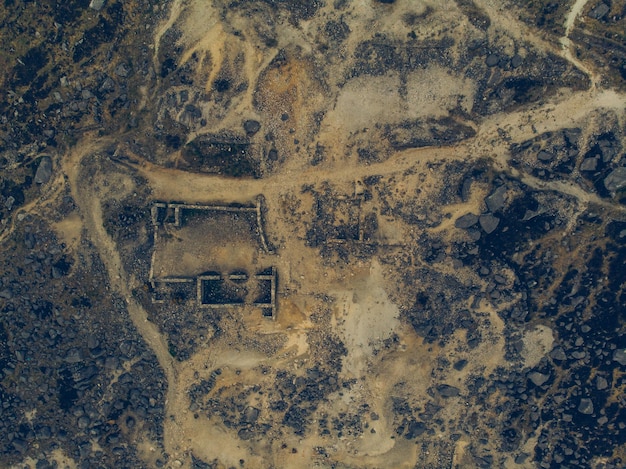
Escalating Intensity: Beyond Frequency
Beyond the sheer number of fires, climate change profoundly impacts their intensity and behavior. More intense fires burn hotter, spread faster, and are far more destructive to ecosystems and human infrastructure. These megafires often generate their own weather systems, creating extreme conditions that challenge traditional firefighting techniques.
One of the key drivers of increased intensity is the abundance of dry, easily combustible fuel. As mentioned, warmer temperatures and drought conditions desiccate vegetation, increasing the amount of fine fuels (grasses, small shrubs) and heavy fuels (large trees, dead wood) available for burning. When these fuels ignite, they release tremendous amounts of energy, leading to higher flame lengths and more rapid rates of spread.
Fuel Loads and Fire Severity
Decades of fire suppression policies, aimed at extinguishing fires quickly, have inadvertently contributed to increased fuel loads in many forests. This, combined with climate-driven drying, creates a dangerous scenario where fires, once they ignite, can consume vast amounts of fuel with unprecedented ferocity. The result is fires that are not only larger but also burn with greater severity, impacting soil health, water quality, and long-term ecosystem recovery.
- Higher heat release: More fuel equals more energy released, leading to hotter fires.
- Spotting: Intense fires can create their own strong updrafts, lifting burning embers and carrying them far ahead of the fire front, starting new blazes.
- Pyrocumulonimbus clouds: Extreme fire activity can generate these massive thunderstorm-like clouds, which can produce lightning and further spread fires.
The increased intensity also makes fires more dangerous for firefighters. Erratic fire behavior, rapid changes in wind direction, and unpredictable fire growth pose significant risks. This necessitates more advanced strategies and technologies for fire suppression, pushing the limits of current resources and budgets.
Furthermore, the increased intensity of wildfires contributes to a vicious feedback loop with climate change itself. High-intensity fires release massive amounts of carbon dioxide and other greenhouse gases into the atmosphere, further contributing to global warming. This, in turn, creates conditions more conducive to future extreme fires, amplifying the problem. This “carbon feedback” is a growing concern for climate scientists, as it can accelerate the warming trend beyond what is projected by other emission sources.
Regional Variations in the US
The impact of climate change on wildfires is not uniform across the US; different regions experience distinct manifestations of this phenomenon. While the Western US often dominates headlines due to its expansive, high-severity fires, other regions are also grappling with evolving fire risks driven by climatic shifts.
The Western US, particularly states like California, Oregon, Washington, and parts of the Southwest, is experiencing longer, hotter, and drier fire seasons. This region is especially vulnerable due to its extensive forests, growing wildland-urban interface, and persistent drought conditions intensified by climate change. The combination of increased temperatures, earlier snowmelt, and a longer dry season significantly extends the period of fire risk, transforming what was once a seasonal issue into a year-round threat.
The Eastern and Southeastern US
While often overlooked in the wildfire narrative, the Eastern and Southeastern US also face significant wildfire challenges, albeit with different drivers. In these regions, climate change can exacerbate fire conditions through shifts in precipitation patterns and increased frequency of extreme weather events. While the fuel types (e.g., dense undergrowth, pine forests) differ from the West, they are equally susceptible to fire under drier or windier conditions.
- Southeastern US: Increased frequency of lightning-ignited fires and human-caused fires. Warmer minimum temperatures can lead to less effective “cold snaps” that would historically reduce fuel moisture.
- Midwest: Drier spring seasons and increased winds can contribute to rapid fire spread in grasslands and agricultural areas.
- Alaska: Experiencing some of the most rapid warming in the US, leading to thawing permafrost and increased fire activity in boreal forests and tundra, releasing stored carbon.
Climate change effects like altered storm tracks can also influence fire weather across the country. For example, shifts in the jet stream can bring prolonged dry spells to regions that historically received steady rainfall, or intensify high-wind events, which are critical for rapid fire spread.
The variations extend to the type of land affected. In the West, it’s often vast forest and wilderness areas that burn, impacting ecosystems and air quality across states. In the Southeast, fires can frequently occur in coastal plain pinelands and are often managed with prescribed burns, but extreme conditions can still lead to uncontrollable blazes. Understanding these regional nuances is essential for developing tailored adaptation and mitigation strategies.
Ecological and Societal Consequences
The increasing frequency and intensity of wildfires, driven by climate change, inflict profound ecological and societal consequences across the US. These impacts extend far beyond the immediate damage of burning landscapes and threaten the long-term health of natural systems and human communities.
Ecologically, intense fires can convert forests into grasslands or shrublands, fundamentally altering ecosystems and reducing biodiversity. They destroy critical wildlife habitats, pushing already vulnerable species closer to extinction. Soil erosion becomes a severe problem after high-severity fires, as the protective vegetation cover is removed. This can lead to increased runoff during rain events, causing mudslides, sedimentation in waterways, and reduced water quality for downstream communities.
Impacts on Air Quality and Human Health
The smoke generated by large wildfires can travel thousands of miles, affecting air quality far from the fire front. Wildfire smoke contains hazardous particulate matter (PM2.5) that can penetrate deep into the lungs, causing respiratory and cardiovascular problems. Vulnerable populations, including children, the elderly, and those with pre-existing conditions, are particularly at risk. Prolonged exposure to smoke can also lead to chronic health issues, highlighting a widespread public health crisis.
- Respiratory illnesses: Asthma attacks, bronchitis, and other breathing difficulties.
- Cardiovascular issues: Increased risk of heart attacks and strokes.
- Mental health: Stress, anxiety, and trauma among affected communities.
Societally, wildfires displace communities, destroy homes and infrastructure, and inflict billions of dollars in economic losses annually. The costs include firefighting efforts, property damage, business interruptions, and long-term recovery. Insurance rates are rising in fire-prone areas, and some insurers are even withdrawing from high-risk markets, leaving homeowners vulnerable. The psychological toll on those who lose homes, livelihoods, or loved ones cannot be overstated.
Moreover, the impacts disproportionately affect marginalized communities, who often lack the resources for adequate preparation, evacuation, or recovery. This exacerbates existing social inequalities and raises questions of environmental justice in the face of climate-driven disasters. The long-term costs of recovery and resilience-building place significant strain on state and federal budgets, diverting funds from other critical public services.
Mitigation and Adaptation Strategies
Addressing the escalating wildfire crisis in the US requires a dual approach: robust mitigation efforts to slow climate change and proactive adaptation strategies to live more safely with fire. Ignoring either aspect will only exacerbate the problem, leading to more frequent and intense fires.
Mitigation primarily involves reducing greenhouse gas emissions to curb global warming. This means transitioning away from fossil fuels to renewable energy sources, improving energy efficiency, and promoting sustainable land-use practices that sequester carbon. International cooperation and national policies are crucial for achieving these large-scale reductions. While the effects of these actions may not be immediately apparent on wildfire patterns, they are fundamental for stabilizing the climate in the long term.
Ecosystem Management and Community Preparedness
Adaptation strategies focus on living with fire more effectively. This includes active forest and land management, such as prescribed burns and targeted thinning, to reduce hazardous fuel loads. Prescribed fire, when safely and strategically applied, can mimic natural fire regimes, reduce the risk of catastrophic blazes, and promote ecosystem health.
- Fuel reduction: Thinning forests, removing dead vegetation, and creating defensible space around structures.
- Community preparedness: Developing evacuation plans, creating fire-resistant building codes, and educating residents on wildfire safety.
- Early detection systems: Investing in technologies like satellites, sensors, and AI to quickly detect and monitor fires.
Investing in resilient infrastructure is another critical adaptation measure. This includes burying power lines, upgrading electrical grids to prevent ignitions, and building homes with fire-resistant materials. Protecting critical water sources and transportation routes is also vital for both firefighting efforts and community safety.
Furthermore, enhancing firefighting capacity through increased funding, advanced training, and innovative technologies is essential. This includes improving aerial firefighting capabilities, utilizing drones for reconnaissance, and deploying real-time data analysis to predict fire behavior. Collaboration between federal, state, and local agencies, as well as with indigenous communities who possess invaluable ancestral knowledge of fire management, is paramount for effective response.
Ultimately, a comprehensive approach must integrate landscape-level planning with community-specific actions. This means fostering cross-boundary collaboration, aligning land management with climate science, and empowering local communities to take ownership of their wildfire risk reduction efforts. The challenge is immense, but the pathways to a more fire-resilient future are clear.

Future Projections and Urgent Action
The trajectory of wildfires in the US, driven by ongoing climate change, points towards a future with even greater frequency and intensity unless significant action is taken. Climate models consistently project warmer temperatures and changes in precipitation patterns that will continue to create conditions highly conducive to extreme fire behavior across many regions of the country. This means that the “new normal” for wildfires will likely involve larger, more destructive, and more frequent events than we have witnessed to date.
Scientists anticipate that fire seasons will continue to lengthen across most of the US, potentially extending year-round in some western and southeastern areas. The number of “very high” and “extreme” fire danger days is projected to increase significantly, making fire suppression more challenging and dangerous. These projections underscore the urgency of both reducing greenhouse gas emissions and accelerating adaptation efforts.
Responding to an Evolving Threat
The scope of the wildfire problem demands an immediate and sustained commitment to both global and local solutions. At the global level, aggressive decarbonization is the only long-term pathway to stabilize the climate and mitigate the most severe impacts, including extreme wildfires. This involves a rapid transition away from fossil fuels, investments in renewable energy, and the development of carbon capture technologies.
- Accelerated decarbonization: Urgent reduction of greenhouse gas emissions across all sectors.
- Enhanced forest resilience: Implementing widespread nature-based solutions and climate-smart forestry practices.
- Cross-sector collaboration: Fostering partnerships between government, academia, industry, and local communities.
Locally and regionally, there is an imperative to scale up proven wildfire resilience strategies. This includes expanding prescribed burning programs, which are essential for reducing hazardous fuel loads and restoring ecological balance to fire-adapted ecosystems. Investing in innovative fire-resistant community design and infrastructure, alongside robust public education campaigns, will also be critical in reducing losses and protecting lives.
Furthermore, recognizing fire as an integral part of many landscapes, rather than solely a destructive force, can inform more effective management. Learning from indigenous fire management practices, which have been refined over millennia to work with fire, not against it, offers valuable insights. The future of wildfires in the US is not predetermined; it is shaped by the decisions and actions we take today to address the root causes of climate change and build more resilient communities.
The economic and social costs of inaction are staggering. Continued escalation of wildfires will strain emergency services, healthcare systems, and insurance markets, creating a domino effect across various sectors. The long-term recovery of ecosystems, which can take decades or even centuries after megafires, further emphasizes the need for proactive measures. The window for effective action is narrowing, making the current moment crucial for shaping a safer, more sustainable future in the face of an evolving wildfire threat.
| Key Factor | Brief Impact Description |
|---|---|
| 🌡️ Rising Temperatures | 🌡️ Lead to drier fuels and extended fire seasons, increasing ignitability and spread. |
| 💧 Prolonged Droughts | 💧 Desiccate vegetation, creating abundant, highly flammable fuel for intense fires. |
| 💨 Altered Wind Patterns | 💨 Can fan flames, accelerate fire spread, and contribute to erratic fire behavior. |
| 🌿 Fuel Accumulation | 🌿 Combined with dryness, creates vast amounts of combustible material for megafires. |
Frequently Asked Questions About Climate Change and Wildfires
▼
No, not all wildfires are directly “caused” by climate change. Many are ignited by human activity (e.g., campfires, power lines) or natural events like lightning. However, climate change significantly contributes to the conditions that make fires more likely to start, spread faster, and burn more intensely, essentially acting as a primary enabler for more extreme fire seasons.
▼
The Western US, including California, Oregon, Washington, and the Southwest, is experiencing profound impacts from climate-driven wildfires due to prolonged droughts and rising temperatures. However, the Southeast and even parts of Alaska are also seeing increased fire activity and extended fire seasons, indicating a broader national challenge.
▼
Wildfires release massive amounts of carbon dioxide (CO2) and other greenhouse gases into the atmosphere when vegetation burns. This re-releases carbon that was stored in plants and soils, contributing to further global warming. Large, intense fires can also permanently alter ecosystems, reducing their capacity to absorb CO2 in the future.
▼
The wildland-urban interface (WUI) is the zone where human development meets or intermingles with undeveloped wildland vegetation. It’s important because it’s where wildfire risk to homes and human lives is highest. Growing populations in WUI areas mean more ignitions from human activity and greater potential for property damage and loss of life during wildfires.
▼
Solutions include reducing greenhouse gas emissions to slow climate change, active forest management (e.g., prescribed burns, thinning) to reduce fuel loads, creating defensible space around homes, implementing fire-resistant building codes, and improving early detection technologies. Community education and preparedness are also crucial for building resilience.
Conclusion
The increasing frequency and intensity of wildfires across the US serve as a stark and undeniable indicator of climate change’s direct and profound impacts. From desiccated landscapes in the West to altered fire regimes in the Southeast, a warming planet is creating conditions that fundamentally reshape how fire interacts with our ecosystems and communities. Understanding this complex interplay is the first step towards building a more fire-resilient future. While the challenge is immense, a concerted effort combining aggressive climate mitigation with proactive adaptation and landscape management can help to restore balance and protect both natural environments and human lives from the escalating threat of wildfires.

